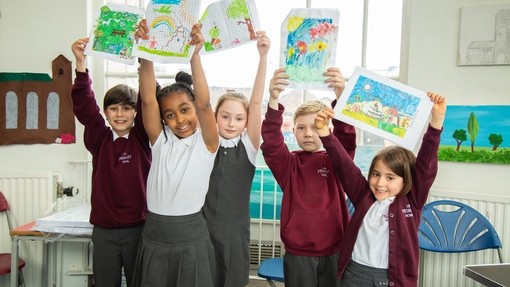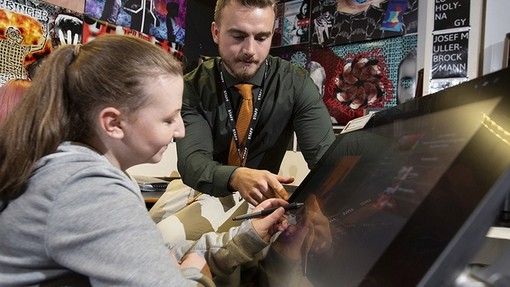
How can creative engagement with buildings and place affect outcomes for teachers?
Content
Architecture defines places. At times buildings excite us, promote positive emotions, offer containment or remind us of momentous events.
This case study outlines the partnership between Oxford University Gardens Libraries and Museums (GLAM) and the Iffley Academy with a focus on how creative engagement with buildings and place, can affect outcomes for teachers.
Iffley Academy is a special school for children with cognition and learning difficulties, where a diverse cohort is celebrated under one roof. It offers county-wide provision and is the largest special school in Oxfordshire.
Over the past three years the University and school have been working on a co-curated project where students with special education needs and disabilities gain equitable access to cultural spaces. This has come in many forms: with students visiting the Ashmolean, the History of Science Museum, displaying their work at the Oxford University Museum of Natural History and working with professional artists to realise creative ideas outside of the classroom.
Much of this work has been about developing the curriculum, however over time it has developed into something more. The links between individuals are really strong - this has enabled teachers to take ownership of public buildings across GLAM, and almost as an extension of the classroom, use them for thinking, planning and collaborating.
Day one of the school year brings most teachers back to an INSET day of sorts, a gloomy school hall and if they’re lucky a few packets of biscuits. We didn’t want this for the start of our year - we wanted teachers to feel enthused, have space to think and be reminded of the core values of our educational offer.
Research tells us that there is a formula to successful continuous professional development, but what it potentially misses, is where this development physically takes place - this is because place really matters, change the environment and you change the behaviour.
“If you have choices around you that are distracting or lead to undesirable outcomes, then it becomes hard to make the right choices. On the flip side, having an environment that only has desirable choices constricts you to do what’s important for yourself.” (*1)
So, wanting to ensure an environment for high impact professional development without stifling creativity we used the Ashmolean as a place of work. This had a really positive effect on wellbeing, productivity and the teachers’ ability to focus on the task at hand.
“In order to have focus we need to escape” (*2)
We told staff in advance that they would be required to meet at the museum allowing them autonomy on how they travelled, where they went afterwards and most importantly encouraged them not to go into school on that day. We wanted staff to tune into the topic and knew that at school there would be constant distractions, preoccupations of lesson preparation and other external demands on their time.
The museum space gave a sense of grandeur to the event. Iffley staff attending the session and the two external speakers commented on the positives of arriving at such an inspiring building.
The beauty here was that the topic was not even about art - but by having the training in a museum we promoted cross pollination of creative thought, set the context for an important event and allowed time for staff to also access exhibitions.
The topic was restorative approaches, a core value of the Iffley Academy, and during the day, much like precious works of art, the museum played host to Dr Belinda Hopkins and Andy Willams, our external speakers. Both specialists in this field, their practice is under-pinned by a robust evidence base and quality assured by the Restorative Justice Council.
Whilst the Ashmolean is a wonderful venue to hold an event, we also know that for professional development to be successful it needs to be sustainable over time, not just a one-off event and it needs to be inter-connected to the curriculum. This is where people were important.
During the session the teachers spent time connecting, engaged in activities in the galleries and talked about how ideas could be revisited and embedded in the curriculum.
Importantly discussion took place with museum staff, the very same staff who have been co-curating the curriculum at Iffley and who will continue to work with us on curriculum development across the coming year.
Teachers reported that they valued the time out of school with the chance to focus and tune in. Wellbeing, an often seemingly un-measurable factor felt strong - upbeat conversations, positive interactions and active engagement, perhaps the most tangible examples.
Our advice to all settings on their Artsmark journey is to get outside your comfort zone and explore your local environment. Yes, that real connection with place takes time, as does good quality professional development. But by connecting with others in new environments, you change your perspective, you allow people to think differently in a different context and by making a small change in venue you can potentially make a big impact on outcomes.
Written by Tom Procter-Legg (Head Teacher Iffley Academy) and Miranda Millward (Arts Engagement Officer, Oxford University Gardens Libraries and Museums). Iffley Academy are working towards their first Artsmark Award.
[1] https://www.inc.com/melissa-chu/its-possible-to-design-your-environment…
[2] Essentialism The Disciplined Pursuit of Less McKeown 2014


